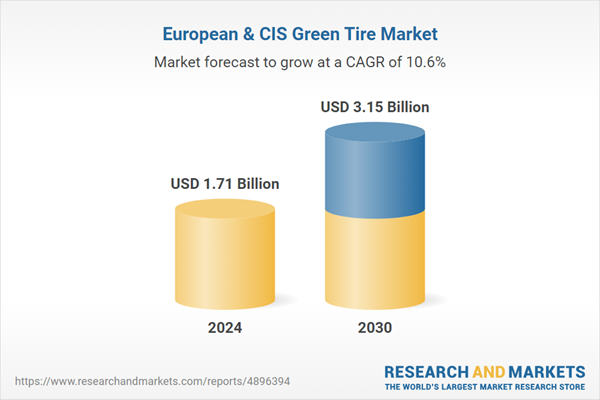Speak directly to the analyst to clarify any post sales queries you may have.
10% Free customizationThis report comes with 10% free customization, enabling you to add data that meets your specific business needs.
Technological advancements in sustainable raw materials, such as bio-based rubbers and recycled content, present significant opportunities for manufacturers to differentiate and meet environmental standards. Consumer preference for eco-conscious products is accelerating the adoption of green tires across both replacement and OEM segments. For instance, as of 2024, Continental incorporated an average of 26% renewable and recycled materials into its tire production, with expectations to increase this share by 2-3 percentage points in 2025. The growth is driven by the integration of sustainable components such as synthetic rubber from renewable or circular oil, recycled PET-based polyester, recycled steel, and silica derived from rice husk ash. Continental targets surpassing 40% sustainable material content by 2030, while maintaining safety and performance standards, as part of its broader commitment to sustainable mobility.
Market Drivers
Rising Stringency in Emission and Fuel Efficiency Regulations
Government-mandated fuel economy and carbon emission regulations are significantly influencing the growth of green tires. Regulatory bodies are pushing automakers and component manufacturers to reduce carbon footprints across the mobility value chain. Green tires, which are designed with low rolling resistance, directly contribute to improved fuel efficiency and reduced CO₂ emissions. Compliance with these mandates has become essential, prompting OEMs to integrate green tires into new vehicle platforms. Beyond legal requirements, carbon taxation and fuel economy standards further incentivize fleets and consumers to choose tires that contribute to fuel savings.Green tires also aid in achieving targets under broader mobility decarbonization goals. Tire makers are leveraging sustainable materials and innovative compound mixes to meet these evolving regulatory thresholds. The pressure to comply is no longer limited to vehicle manufacturers; tire producers now play a key role in meeting national and industry-wide sustainability benchmarks.
For instance, Starting January 1, 2025, the EU will enforce new CO₂ emission standards under Regulations (EU) 2023/851 and 2019/631, setting fleet-wide targets of 95 g CO₂/km for new passenger cars and 147 g CO₂/km for vans. By 2035, only zero-emission vehicles will be permitted for sale, with noncompliant manufacturers facing penalties of €95 per g/km per vehicle. To meet these targets, automakers must increase electric vehicle sales to at least 25% and may utilize mechanisms such as super-credits for ZLEVs, eco-innovation credits, and manufacturer pooling - each governed by strict compliance and antitrust rules.
Key Market Challenges
High Production Costs of Eco-Friendly Materials
The cost of manufacturing green tires remains significantly higher than conventional alternatives due to the use of premium raw materials such as silica, natural rubber blends, and bio-based polymers. These materials are often more expensive to procure and process, leading to elevated input costs. Sustainable production techniques, while environmentally beneficial, may involve advanced technologies and process modifications that increase overhead. Smaller manufacturers face greater pressure due to limited economies of scale, making it difficult to offer green tires at competitive price points. Cost-sensitive consumers and budget-conscious fleet operators may hesitate to adopt green tires despite long-term savings, particularly when upfront costs remain high.Key Market Trends
Adoption of Silica-Based and Smart Compound Technologies
Silica-based tread compounds have emerged as a cornerstone of green tire innovation, replacing traditional carbon black to lower rolling resistance and improve wet traction. The use of advanced compound technologies allows manufacturers to achieve a balance between energy efficiency and safety performance, which had previously been difficult. Smart compound technologies, including nano-fillers and advanced polymers, are enhancing tire durability and optimizing weight-to-strength ratios. These compounds allow for better heat dispersion, improved flexibility, and prolonged tread life, all while supporting environmental performance targets. The increased adoption of these technologies signifies a shift from traditional tire engineering toward precision chemical design. As consumers and OEMs demand tires that are both eco-friendly and high-performing, the use of smart compounds offers a competitive edge.Key Market Players
- Compagnie Générale des Établissements Michelin
- Bridgestone Europe NV/SA
- Continental AG
- Goodyear Dunlop Tires Europe B.V.
- Pirelli & C. S.p.A.
- Nokian Tyres PLC
- Hankook Reifen Deutschland GmbH
- Yokohama Europe Gmbh
- Apollo Vredestein B.V.
- Cooper Tire & Rubber Company Europe Limited
Report Scope:
In this report, the Europe & CIS Green Tire Market has been segmented into the following categories, in addition to the industry trends which have also been detailed below:Europe & CIS Green Tire Market, By Demand Category:
- OEM
- Replacement
Europe & CIS Green Tire Market, By Vehicle Type:
- Passenger Cars
- Commercial Vehicle
Europe & CIS Green Tire Market, By Country:
- Germany
- Russia
- France
- Spain
- Italy
- United Kingdom
- Poland
- Rest of Europe & CIS
Competitive Landscape
Company Profiles: Detailed analysis of the major companies present in the Europe & CIS Green Tire Market.Available Customizations:
With the given market data, the publisher offers customizations according to the company’s specific needs. The following customization options are available for the report.Company Information
- Detailed analysis and profiling of additional market players (up to five).
This product will be delivered within 1-3 business days.
Table of Contents
Companies Mentioned
- Compagnie Générale des Établissements Michelin
- Bridgestone Europe NV/SA
- Continental AG
- Goodyear Dunlop Tires Europe B.V.
- Pirelli & C. S.p.A.
- Nokian Tyres PLC
- Hankook Reifen Deutschland GmbH
- Yokohama Europe Gmbh
- Apollo Vredestein B.V.
- Cooper Tire & Rubber Company Europe Limited
Table Information
| Report Attribute | Details |
|---|---|
| No. of Pages | 135 |
| Published | July 2025 |
| Forecast Period | 2024 - 2030 |
| Estimated Market Value ( USD | $ 1.71 Billion |
| Forecasted Market Value ( USD | $ 3.15 Billion |
| Compound Annual Growth Rate | 10.6% |
| Regions Covered | Europe, Russia |
| No. of Companies Mentioned | 10 |









